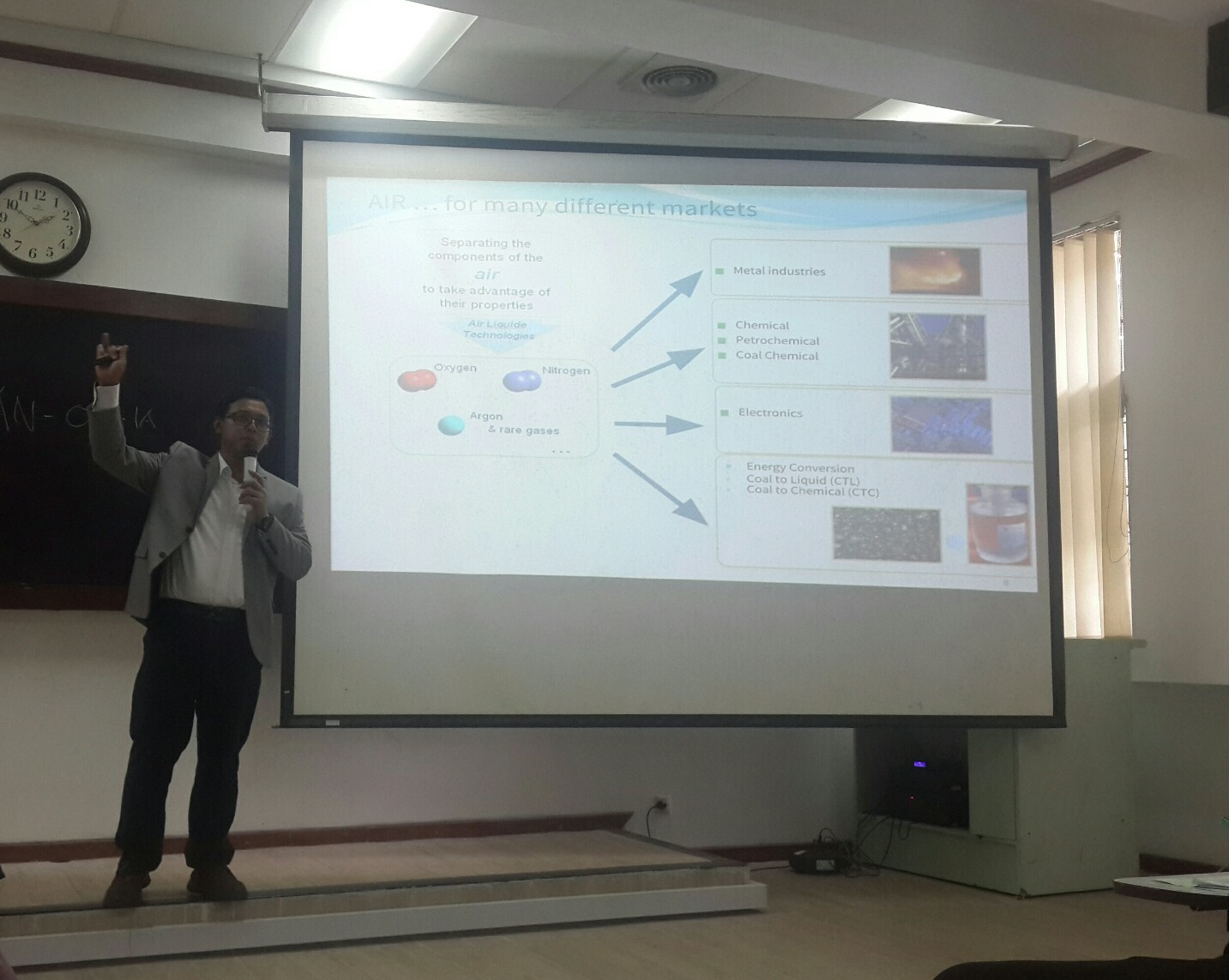Scientific Speech by Prof. Danu Ariono: Development of Diffusional Separation Technology in Chemical Industries

*Prof. Danu Ariono in a scientific oration regarding development of diffusional separation technology, delivered at Aula Barat of ITB on Saturday (21/9/2019). (Photo by: E-Learning of ITB).
BANDUNG, itb.ac.id – Separation process technology is an important process in chemical industry. In general, the function of separation process in industries is to separate dirty substance, purify the products, and remove existing contaminants. The results of the process are byproducts and recycle flow.
Traditional separation technology continues to develop especially in its energy efficiency, cost effectively, and raw materials use. Therefore, development to separation technologies, diffusional separation including, should be made to support efficiency of chemical process. This problem is the main focus of scientific speech delivered by Prof. Danu Ariono on Saturday, 21 September 2019 at Aula Barat of ITB.
In the scientific speech entitled Development of Diffusional Separation Technology, Prof. Danu said that development of separation processes based on phase equilibrium still continues. “In this category, absorption and distillation are processes that experience rapid development. It is due to both processes are the most used in industry and remain irreplaceable,” he said.
Separation Technology in Industries
Distillation is a separation method based on materials’ volatility. In distillation, mixture of substances is boiled until it evaporates, and the vapor is cooled down into liquid form. Whereas Absorption, on the other hand, is a physical or chemical phenomenon or a process in which atoms, molecules, or ions enter some bulk phase – liquid or solid material. Those processes rely on a phenomenon called diffusion, a transfer of mass or substance in a non-equilibrium condition.
“In industry, one of the development to the process of distillation is reactive distillation which combine chemical reaction and distillation process. This process is one of important industrial application from multifunctional reactor concept. The advantages of this process is its enhancement to process efficiency and its simple design, in this process, when reactant change to products, hence, automatically it will separate reactant from the product through distillation process,” he explained.
In addition to reactive distillation, industrial separation process also uses ionic solutions in absorption process. Ionic solutions are used to replace absorbent solution that contains volatile organic compounds such as amine solutions.
“After that, evaluation method is conducted in industry for liquid-liquid extraction, which is a liquid mixture separation process under certain conditions. This process has the advantage of being able to be operated in relatively small room and uses relatively low energy. Usually, liquid-liquid extraction is used at petroleum industries to separate aromatic compounds, sulfur, waxes, and resins,” said Prof. Danu.
Development of Separation Process in Chemical Industries
A common and favorable method used in chemical industry is distillation. Hence, various methods of operation and combination with other separation processes are carried out so that distillation process becomes more effective and efficient. There are several developments of distillation technology, such as cyclic distillation, hybrid distillation, membrane distillation, HiGee distillation, and internally heat integrated method.
In industrial scale, chemical process in general is always followed with separation process. Reactive Distillation, as mentioned above, is a promising process. “However, the application of reactive distillation is constrained by same temperature and pressure for distillation and reaction so that it is more suitable to apply at heterogeneous catalysis reaction process,” said Prof. Danu, an alumnus of Universite de Technologie de Compiegne, France.
Besides reactive distillation, development is done to reactive adsorption, which is the integration of adsorption process with chemical process where adsorption process and chemical reaction are in one operating unit. This system is usable to improve elemental sulfur uptake from acid gas.
One of applications of the above technological developments is quality enhancement process of limestone using circulating reactors. Indonesia has abundant limestone potential so that it can be managed optimally. “To improve its quality, CaCO3 (limestone) are usually burned at 800-900 Celsius to produce CaO (lime) and CO2. CaO is fragile. After that, hydratation process which involves water is conducted to create (Ca(OH)2). The next process is to react slaked lime with CO2 to create higher quality CaCO3,” explained Prof. Danu.
Reporter: Billy Akbar Prabowo (Metallurgical Engineering 2016)
In the scientific speech entitled Development of Diffusional Separation Technology, Prof. Danu said that development of separation processes based on phase equilibrium still continues. “In this category, absorption and distillation are processes that experience rapid development. It is due to both processes are the most used in industry and remain irreplaceable,” he said.
Separation Technology in Industries
Distillation is a separation method based on materials’ volatility. In distillation, mixture of substances is boiled until it evaporates, and the vapor is cooled down into liquid form. Whereas Absorption, on the other hand, is a physical or chemical phenomenon or a process in which atoms, molecules, or ions enter some bulk phase – liquid or solid material. Those processes rely on a phenomenon called diffusion, a transfer of mass or substance in a non-equilibrium condition.
“In industry, one of the development to the process of distillation is reactive distillation which combine chemical reaction and distillation process. This process is one of important industrial application from multifunctional reactor concept. The advantages of this process is its enhancement to process efficiency and its simple design, in this process, when reactant change to products, hence, automatically it will separate reactant from the product through distillation process,” he explained.
In addition to reactive distillation, industrial separation process also uses ionic solutions in absorption process. Ionic solutions are used to replace absorbent solution that contains volatile organic compounds such as amine solutions.
“After that, evaluation method is conducted in industry for liquid-liquid extraction, which is a liquid mixture separation process under certain conditions. This process has the advantage of being able to be operated in relatively small room and uses relatively low energy. Usually, liquid-liquid extraction is used at petroleum industries to separate aromatic compounds, sulfur, waxes, and resins,” said Prof. Danu.
Development of Separation Process in Chemical Industries
A common and favorable method used in chemical industry is distillation. Hence, various methods of operation and combination with other separation processes are carried out so that distillation process becomes more effective and efficient. There are several developments of distillation technology, such as cyclic distillation, hybrid distillation, membrane distillation, HiGee distillation, and internally heat integrated method.
In industrial scale, chemical process in general is always followed with separation process. Reactive Distillation, as mentioned above, is a promising process. “However, the application of reactive distillation is constrained by same temperature and pressure for distillation and reaction so that it is more suitable to apply at heterogeneous catalysis reaction process,” said Prof. Danu, an alumnus of Universite de Technologie de Compiegne, France.
Besides reactive distillation, development is done to reactive adsorption, which is the integration of adsorption process with chemical process where adsorption process and chemical reaction are in one operating unit. This system is usable to improve elemental sulfur uptake from acid gas.
One of applications of the above technological developments is quality enhancement process of limestone using circulating reactors. Indonesia has abundant limestone potential so that it can be managed optimally. “To improve its quality, CaCO3 (limestone) are usually burned at 800-900 Celsius to produce CaO (lime) and CO2. CaO is fragile. After that, hydratation process which involves water is conducted to create (Ca(OH)2). The next process is to react slaked lime with CO2 to create higher quality CaCO3,” explained Prof. Danu.
Reporter: Billy Akbar Prabowo (Metallurgical Engineering 2016)

scan for download






